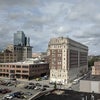Main Street revamp questioned by local businesses
Walk down Worcester’s Main Street and you’ll see crumbling and sometimes cramped sidewalks, incongruent styles of lighting, and crater-sized potholes that reveal the brick foundation underlying it all.
Cars jockey for position across four travel lanes – two heading north, two south - only to get trapped at a red light on a clear street, with a green signal tantalizingly close, yet a block away. This is the downtown Worcester of today. But it will not be the Worcester downtown of tomorrow if the city completes its plan to rip up and reengineer Main Street between the federal and Worcester County courthouses.
The streetscape plan is estimated to cost $7.5 million, with most of that — $4.5 million — coming from the federal government. It will cut in half the number of travel lanes, adding a turning lane in the median and bicycle paths along the sides. Nine of the 11 traffic lights along the stretch would be synchronized to improve traffic flow, and the sidewalks would be ripped up and replaced to make them more accommodating to handicapped pedestrians. Meanwhile, there will be less on-street parking with the loss of 22 spaces.
But will these changes help boost a downtown business community in an area where — some business owners say — activity slows down after 4 p.m.? And, can the new look help pull in additional businesses?
Given what some businesses in and around Main Street say they’re facing, it could be tough to convince them.
Troy Siebels is “psyched” about the plan, the executive director of The Hanover Theatre for the Performing Arts told a gathering of business leaders in late July at the offices of the Worcester Regional Chamber of Commerce. But he said it won’t address all of downtown’s problems.
Last month, he told the WBJ: “I think it’ll make it look nicer and it will actually count for something.”
But the chief questions for downtown businesses – especially in the retail industry – are whether a redesigned streetscape will bring in more customers and if there will be enough parking to accommodate them.
Judging from the reactions of a couple of business owners over the past several weeks, the city needs to take a longer look at the plans.
“There is no incentive for anybody to stay downtown,” Zach Photakis, owner of The Owl Shop tobacco store, told the chamber gathering. “Main Street is an absolute ghost town from 4 o’clock on.” The addition of more college students in the area hasn’t helped enough, he told the WBJ last month.
Photakis added that downtown parking is critical and he “strongly” urged city officials to look at what would be lost in downtown parking availability. “There’s not enough (parking) as it is,” he said.
About 400 yards to the south, across from the Hanover Theatre, Bill Aldrich expresses a similar sentiment as owner of the Theatre Cafe. “Increased parking is an advantage to me,” he says. But that advantage is apparently lost, he adds, when residents fill local parking spots.
While it might seem that these changes will stifle automobile traffic, the synchronized lights will claw back any losses from the lower number of lanes and, in some instances, even improve traffic flow, according to Paul Moosey, Worcester’s commissioner of public works and parks. The addition of bike lanes and improved handicapped accessibility of sidewalks are not only required to get state and federal funding, but will be important as more people move downtown, he said.
“We are anticipating more residential units in the downtown area, so (the) need (for biking) will develop over time,” he said. “It’s a good amenity and something that will enhance (the downtown).”
Most concerns that have been raised about the project were less about traffic flow and revolved around a more holistic view of downtown. Yet Moosey emphasized that more conversations are needed regarding the project.
The project also has the duty of carrying forward a brighter image of Worcester as city officials and organizations continue to promote the city to outside businesses and the employees on which those businesses will rely.
“Details matter and having an inviting, aesthetically pleasing, well lit street … it matters,” chamber President and CEO Tim Murray says. “Downtown is everybody’s neighborhood and Main Street is a symbol of what every city and town is about.”
Sprucing up downtown through such projects and making it a more walkable environment will help the city attract more companies, he added. Being able to show a vibrant downtown environment, as officials continue to push for an “18 hour a day” downtown, will be a major selling point, Murray said.
At the July meeting, Randy Feldman, an attorney with a downtown office, urged city planners to give the area a unique look.
Worcester’s “downtown remains completely unexceptional,” he said. “We have to do something dramatically nicer.”
Tim McGourthy, executive director of the Worcester Regional Research Bureau, agrees with Murray’s assessment. One of the city’s major benefits over other communities that compete for businesses and residents is that urban feel with an actual downtown, he said.
“Having a vibrant center will drive activity not only in the downtown but also in surrounding neighborhoods and areas,” McGourthy said.
However, the businesses and property owners downtown must be ready to capitalize on the improvements, he added, investing in the exteriors of their buildings and be ready to refurbish ground-level retail spaces to attract new tenants. Many of Worcester’s downtown buildings were built in the 1940s and 1950s with integrated ground-level retail space. Building owners can take advantage of that with downtown improvements, McGourthy said.
“The basic framework of the buildings and structures lend themselves to the types of uses the city wants to encourage in the downtown,” McGourthy said. “The government can make an area that’s walkable, but it takes private industry to make destinations worth walking to.”










0 Comments